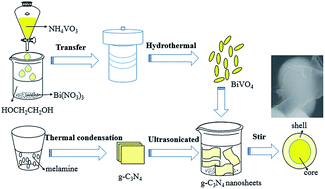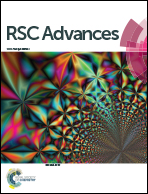Synthesis and characterization of a core–shell BiVO4@g-C3N4 photo-catalyst with enhanced photocatalytic activity under visible light irradiation†
Abstract
Novel core–shell structured ellipsoid-like BiVO4@g-C3N4 composites, with different amounts of g-C3N4, have been successfully prepared by a simple hydrothermal-chemisorption method. Their performance as photocatalysts was systematically evaluated during RhB degradation under visible light irradiation. The composite with 7 wt% g-C3N4 was found to be 7 times more efficient as a photocatalyst than pristine BiVO4. Its core–shell structure and activity were also found to be highly stable after it was used for 5 times in RhB degradation. The new composites were examined by various characterization techniques. The core–shell structure enhanced the contact area between the BiVO4 core and g-C3N4 nano-sheet shell, which provided more active sites and strengthened the chemical band interaction. The thin g-C3N4 nano-sheets reduced the charge carrier transfer distance, which further suppressed the recombination of the photo-induced electron–hole pairs and therefore enhanced the photocatalytic activity of the composites. A reaction mechanism of the photocatalytic RhB degradation was proposed and discussed in detail.

- This article is part of the themed collection: 2017-2018 Top Cited Research from China


 Please wait while we load your content...
Please wait while we load your content...